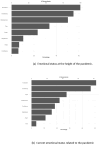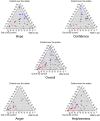Insights from the front line: uplifting stories of the COVID-19 pandemic through the eyes of the public health workforce in Iowa
- PMID: 40771255
- PMCID: PMC12325277
- DOI: 10.3389/fpubh.2025.1597941
Insights from the front line: uplifting stories of the COVID-19 pandemic through the eyes of the public health workforce in Iowa
Abstract
Introduction: SARS-CoV-2 was declared a pandemic in March 2020. Studies have characterized some of the negative impact of the pandemic on public health workers (PHW), but few have explored the strength and coping strategies used. Our study documents the experiences of PHW in Iowa during the pandemic.
Methods: We used an innovative mixed methods data collection tool, SenseMaker® to gather stories from PHW in Iowa between March and July 2022. Participants provided additional data about their story via structured follow-up questions. We conducted descriptive analyses of the quantitative questions. A qualitative thematic and sentiment analysis was applied to all stories.
Results: The final sample size was 163 stories. PHW who submitted stories identified as mostly white (93.9%), and women (83.4%). Respondents were most likely to feel that in the story they told: the ability to act was out of their control; the strongest influence was from political considerations; decisions were made out of necessity; they wished for more focus on evidence-based public health. PHW were most likely to describe their emotional state at the height of the pandemic as frustration (61%), uncertainty (55%), and helplessness (50%). Those who felt in control were more likely to express positive emotions. Qualitative thematic analysis of these stories revealed 8 themes, highlighting facilitators (e.g., strong partnerships and collaborations) and barriers (e.g., politicization and controversial government response) to effective pandemic response.
Discussion: The stories PHW shared powerfully illustrate the context of the pandemic in Iowa, a state that spent the least time under high stringency policies.
Keywords: COVID-19; SenseMaker; mental health; mixed-methods; public health workforce; rural health.
Copyright © 2025 Haines, Sursely, Pham, Beltran, Sewell, Reinders, Askelson, Dixon, Emrich, Estle, Lewis, Parker, Reyes, Walkner, Sittig and Afifi.
Conflict of interest statement
The authors declare that the research was conducted in the absence of any commercial or financial relationships that could be construed as a potential conflict of interest.
Figures






Similar articles
-
Measures implemented in the school setting to contain the COVID-19 pandemic.Cochrane Database Syst Rev. 2022 Jan 17;1(1):CD015029. doi: 10.1002/14651858.CD015029. Cochrane Database Syst Rev. 2022. Update in: Cochrane Database Syst Rev. 2024 May 2;5:CD015029. doi: 10.1002/14651858.CD015029.pub2. PMID: 35037252 Free PMC article. Updated.
-
Antibody tests for identification of current and past infection with SARS-CoV-2.Cochrane Database Syst Rev. 2022 Nov 17;11(11):CD013652. doi: 10.1002/14651858.CD013652.pub2. Cochrane Database Syst Rev. 2022. PMID: 36394900 Free PMC article.
-
Community First Responders' role in the current and future rural health and care workforce: a mixed-methods study.Health Soc Care Deliv Res. 2024 Jul;12(18):1-101. doi: 10.3310/JYRT8674. Health Soc Care Deliv Res. 2024. PMID: 39054745
-
Factors that influence participation in physical activity for people with bipolar disorder: a synthesis of qualitative evidence.Cochrane Database Syst Rev. 2024 Jun 4;6(6):CD013557. doi: 10.1002/14651858.CD013557.pub2. Cochrane Database Syst Rev. 2024. PMID: 38837220 Free PMC article. Review.
-
Signs and symptoms to determine if a patient presenting in primary care or hospital outpatient settings has COVID-19.Cochrane Database Syst Rev. 2022 May 20;5(5):CD013665. doi: 10.1002/14651858.CD013665.pub3. Cochrane Database Syst Rev. 2022. PMID: 35593186 Free PMC article.
References
-
- World Health Organization . WHO Director-General's Opening Remarks at the Media Briefing on COVID-19 (2020). Available online at: https://www.who.int/director-general/speeches/detail/who-director-genera... (Accessed March 11, 2020).
-
- Centers for Disease Control and Prevention . CDC Museum COVID-19 Timeline (2023). Available online at: https://www.cdc.gov/museum/timeline/covid19.html (Accessed July 1, 2025).
-
- Radley DC, Baumgartner JC, Collins SR. 2022 Scorecard on State Health System Performance: How did states do during the COVID-19 pandemic? The Commonwealth Fund (2022). Available online at: https://www.commonwealthfund.org/publications/scorecard/2022/jun/2022-sc... (Accessed July 1, 2025).
-
- President's Council of Advisors on Science and Technology (2023) . Report to the President: Supporting the US Public Health Workforce. Washington: Executive Office of the President.
MeSH terms
LinkOut - more resources
Full Text Sources
Medical
Miscellaneous

